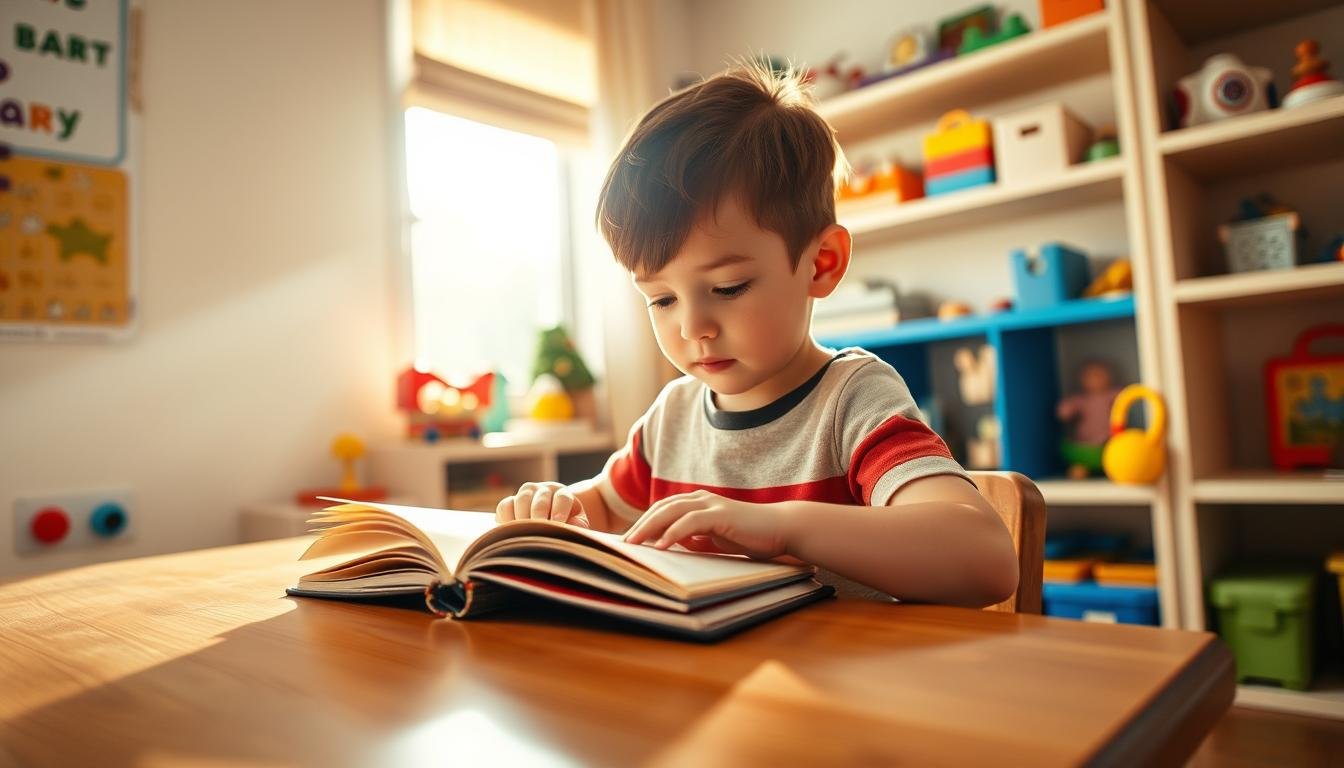Is it possible to ensure your child excels academically while still enjoying their childhood? Many parents grapple with this question as they strive to create a healthy balance between structured learning and free play.
Modern life often pushes academic rigor, but playtime is equally vital for a child’s development. Structured activities and free play work together to enhance cognitive and social skills. For example, The Gardner School’s blended curriculum combines play-based learning with S.T.E.A.M. activities, fostering both creativity and critical thinking.
Finding this balance not only prepares children for school but also instills lifelong learning habits. It’s about creating an environment where education and fun coexist seamlessly. With the right strategies, parents can help their child thrive academically while nurturing their natural curiosity and joy.
Key Takeaways
- Structured learning and free play complement each other for a child’s growth.
- Play-based learning enhances creativity and critical thinking.
- A balanced approach prepares children for school and beyond.
- Parents can create routines that integrate both study and play.
- Optimizing the environment encourages a seamless blend of learning and fun.
Why Balancing Study and Play is Essential for Kids
A child’s growth thrives when both learning and fun are prioritized. Combining structured tasks with creative play fosters well-rounded development. This approach not only enhances academic performance but also builds essential life skills.
The Role of Play in Child Development
Play is a powerful tool for a child’s development. It boosts problem-solving abilities, language skills, and social competence. For example, role-playing games like “house” teach conflict resolution and teamwork.
Research from the Gardner School highlights how play-based activities, such as S.T.E.A.M. experiments, introduce foundational science concepts. Brookeville studies also show that recess breaks improve classroom focus and reduce stress.
The Importance of Structured Study Time
Structured study builds discipline and working memory. Reading routines and task completion help children develop focus and organizational skills. Early reading habits, for instance, correlate with kindergarten readiness.
While play encourages independence, structured study teaches responsibility. This combination prepares children for school and beyond, fostering confidence and a love for learning.
How to Balance Study and Play for Kids: Practical Tips
Finding the right mix of structured tasks and creative activities can shape a child’s day positively. A well-planned routine ensures they stay engaged while developing essential skills. Here are some practical strategies to help parents create a seamless blend of learning and fun.

Create a Structured Daily Routine
A consistent schedule provides a sense of stability for children. Start by dividing the day into manageable blocks of time. For younger kids, visual timetables with color-coded tasks can make the routine more engaging.
For older children, the Pomodoro Technique works well. Focus for 25 minutes, then take a 5-minute break. This method keeps them productive while allowing short bursts of relaxation. Adjust the schedule weekly based on energy levels and school demands.
Incorporate Play-Based Learning Activities
Play-based activities make learning enjoyable and effective. Cooking together, for example, can teach math and vocabulary. Measuring ingredients or counting LEGO bricks turns games into educational moments.
Rotate between free play, like backyard exploration, and guided activities, such as museum visits. This variety keeps children curious and motivated. The Gardner School’s approach of blending child-initiated and teacher-led tasks is a great example of this balance.
By integrating learning into play, parents can help their child develop critical skills while having fun. A structured yet flexible routine ensures they thrive academically and socially.
Creating an Effective Study Environment
Setting up a productive study environment can significantly impact a child’s academic success. A well-organized space minimizes distractions and helps children stay focused during learning sessions. By designing a dedicated area for tasks, parents can support their child’s ability to concentrate and complete assignments efficiently.
Designate a Quiet Study Space
Choose a low-traffic area away from TVs and toys to create a distraction-free zone. The Gardner School’s classrooms are designed to enhance concentration, and a similar approach at home can yield great results. Equip the space with organizers for pencils, calculators, and notebooks to keep everything within reach.
Ergonomic furniture, like adjustable chairs and desks, improves posture during long study hours. For older children, consider implementing “study zones” where siblings respect quiet hours. This fosters a sense of responsibility and helps maintain focus.
Ensure Access to Necessary Study Materials
Stock the study environment with all essential materials. For younger kids, this includes physical items like crayons and rulers. Older children may benefit from digital tools, such as grammar-check apps, alongside traditional textbooks.
Having everything readily available reduces interruptions and keeps the child engaged. This approach not only supports academic growth but also teaches organizational skills that are valuable in school and beyond.
Encouraging Active Play for Physical and Mental Health
Active play is a cornerstone of a child’s development, fostering both physical health and mental well-being. Engaging in movement and creative games helps children build motor skills and maintain high energy levels. Whether outdoors or indoors, playtime is essential for a child’s growth.

Benefits of Outdoor Activities
Outdoor activities like soccer, cycling, or nature walks are excellent for coordination and reducing screen time. These games also encourage teamwork and problem-solving. Local zoos or science centers, as recommended by The Gardner School, offer educational yet fun experiences.
Daily outdoor time can include scavenger hunts or sports. Pairing physical play with learning, such as jumping rope while reciting multiplication tables, makes the experience both productive and enjoyable.
Indoor Play Options for Rainy Days
When the weather doesn’t cooperate, indoor activities like yoga or dance parties keep children active. Creating obstacle courses with pillows or cushions can improve agility and provide fun challenges.
Limiting sedentary screen time to one hour post-study sessions ensures children stay active even on rainy days. These indoor options maintain their energy and keep them engaged in a healthy way.
Teaching Time Management Skills
Effective time management is a skill that benefits children throughout their lives. Teaching kids to manage their time helps them complete tasks efficiently and fosters independence. By introducing age-appropriate tools, parents can guide their children toward achieving their goals while maintaining a healthy routine.
Using Visual Timetables for Younger Kids
Visual aids like charts and planners are excellent for younger children. Laminated weekly planners with Velcro activity cards make the schedule interactive and fun. Adding stickers as rewards for completed tasks motivates kids to stay on track.
These tools also teach prioritization. For example, children learn to distinguish between urgent homework and long-term projects. This approach helps them develop a sense of responsibility and prepares them for more complex study sessions later on.
Introducing Digital Tools for Older Children
For teens, digital tools like Trello or Focus@Will can enhance productivity. These apps help track assignments and set deadline alerts, making it easier to manage time. Demonstrating how to use these tools encourages self-assessment and accountability.
Gradually shifting responsibility, such as letting teens plan their Saturdays, builds confidence. This practice not only improves their organizational skills but also prepares them for future challenges. By combining visual aids and digital tools, parents can help children develop lifelong time management habits.
Conclusion: Fostering a Healthy Balance for Your Child
Building a nurturing environment for your child’s growth requires a thoughtful approach. The Gardner School’s play-based curriculum seamlessly blends creativity with academic rigor, fostering a healthy balance that supports both learning and joy.
Flexibility is key. Adjust routines to accommodate unexpected events or shifts in mood. This adaptability ensures your child remains engaged and motivated throughout their journey.
Long-term outcomes are equally important. Confident learners with strong time management skills are better prepared for school and beyond. Share strategies with other caregivers to maintain consistency in their daily experiences.
For tailored support, explore Gardner School’s Diamond Study Skills program. It’s designed to empower children with the tools they need for success in academics and life.
FAQ
Why is balancing study and play important for children?
Balancing study and play helps children develop essential skills like focus, creativity, and physical health. It ensures they grow academically while enjoying their childhood experiences.
How can parents create a structured daily routine for kids?
Parents can set specific times for tasks, such as homework, reading, and outdoor activities. A consistent schedule helps children manage their day effectively.
What are some play-based learning activities for kids?
Activities like educational games, puzzles, and arts and crafts combine fun with learning. These experiences enhance problem-solving and creativity.
How can parents design a quiet study space at home?
Choose a calm area with minimal distractions. Ensure the space has proper lighting, a comfortable chair, and access to necessary materials like books and stationery.
What are the benefits of outdoor play for children?
Outdoor activities improve physical health, boost confidence, and encourage social interaction. They also help kids develop motor skills and reduce stress.
How can parents teach time management skills to younger kids?
Visual timetables with pictures or colors can help younger children understand their daily tasks. This method makes it easier for them to follow a routine.
What digital tools can older children use for time management?
Apps like Google Calendar, Trello, or Todoist help older kids organize their study sessions and playtime. These tools teach responsibility and planning.
How can parents ensure a healthy balance between school and play?
Encourage a mix of academic tasks and fun activities. Regularly check in with your child to adjust their schedule based on their needs and goals.






